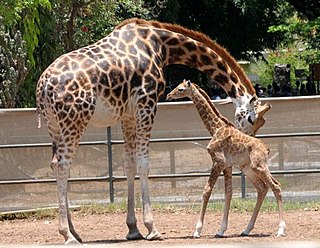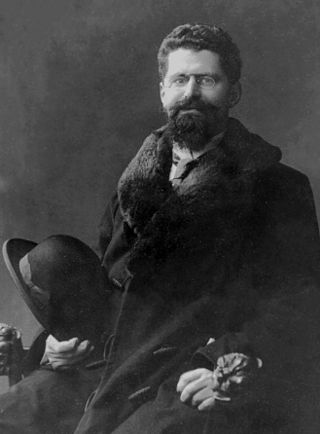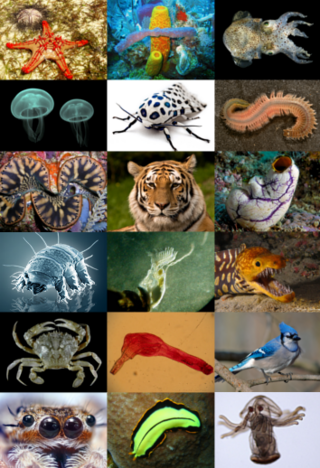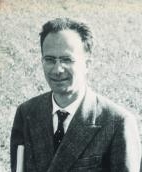Related Research Articles

Evolutionary developmental biology is a field of biological research that compares the developmental processes of different organisms to infer how developmental processes evolved.

In evolutionary developmental biology, heterochrony is any genetically controlled difference in the timing, rate, or duration of a developmental process in an organism compared to its ancestors or other organisms. This leads to changes in the size, shape, characteristics and even presence of certain organs and features. It is contrasted with heterotopy, a change in spatial positioning of some process in the embryo, which can also create morphological innovation. Heterochrony can be divided into intraspecific heterochrony, variation within a species, and interspecific heterochrony, phylogenetic variation, i.e. variation of a descendant species with respect to an ancestral species.

Francesco Severi was an Italian mathematician. He was the chair of the committee on Fields Medal on 1936, at the first delivery.

A body plan, Bauplan, or ground plan is a set of morphological features common to many members of a phylum of animals. The vertebrates share one body plan, while invertebrates have many.

Biological or process structuralism is a school of biological thought that objects to an exclusively Darwinian or adaptationist explanation of natural selection such as is described in the 20th century's modern synthesis. It proposes instead that evolution is guided differently, basically by more or less physical forces which shape the development of an animal's body, and sometimes implies that these forces supersede selection altogether.

Phytomorphology is the study of the physical form and external structure of plants. This is usually considered distinct from plant anatomy, which is the study of the internal structure of plants, especially at the microscopic level. Plant morphology is useful in the visual identification of plants. Recent studies in molecular biology started to investigate the molecular processes involved in determining the conservation and diversification of plant morphologies. In these studies transcriptome conservation patterns were found to mark crucial ontogenetic transitions during the plant life cycle which may result in evolutionary constraints limiting diversification.

Wallace Arthur is an evolutionary biologist and science writer. He is Emeritus Professor of Zoology at the University of Galway. His most recent book is Understanding Life in the Universe, published by Cambridge University Press, which focuses on the likely extent and nature of extraterrestrial life. He was one of the founding editors of the journal Evolution & Development, serving as an editor for nearly 20 years. He has held visiting positions at Harvard University, Darwin College Cambridge, and the University of Warmia and Mazury in Olsztyn, Poland.

In evolutionary developmental biology, the concept of deep homology is used to describe cases where growth and differentiation processes are governed by genetic mechanisms that are homologous and deeply conserved across a wide range of species.

Gerd B. Müller is an Austrian biologist who is emeritus professor at the University of Vienna where he was the head of the Department of Theoretical Biology in the Center for Organismal Systems Biology. His research interests focus on vertebrate limb development, evolutionary novelties, evo-devo theory, and the Extended Evolutionary Synthesis. He is also concerned with the development of 3D based imaging tools in developmental biology.
Rolf Sattler FLS FRSC is a Canadian plant morphologist, biologist, philosopher, and educator. He is considered one of the most significant contributors to the field of plant morphology and "one of the foremost plant morphologists in the world." His contributions are not only empirical but involved also a revision of the most fundamental concepts, theories, and philosophical assumptions. He published the award-winning Organogenesis of Flowers (1973) and nearly a hundred scientific papers, mainly on plant morphology. As well he has contributed to many national and international symposia and also organized and chaired symposia at international congresses, edited the proceedings of two of them and published them as books.

Guido Zappa was an Italian mathematician and a noted group theorist: his other main research interests were geometry and also the history of mathematics. Zappa was particularly known for some examples of algebraic curves that strongly influenced the ideas of Francesco Severi.
Ralf Josef Sommer is a German biologist specializing in evolutionary developmental biology.
Federico Cafiero was an Italian mathematician known for his contributions in real analysis, measure and integration theory, and in the theory of ordinary differential equations. In particular, generalizing the Vitali convergence theorem, the Fichera convergence theorem and previous results of Vladimir Mikhailovich Dubrovskii, he proved a necessary and sufficient condition for the passage to the limit under the sign of integral: this result is, in some sense, definitive. In the field of ordinary differential equations, he studied existence and uniqueness problems under very general hypotheses for the left member of the given first order equation, developing an important approximation method and proving a fundamental uniqueness theorem.
Dionigi Galletto was an Italian mathematician and academician.

Luigi Amerio, was an Italian electrical engineer and mathematician. He is known for his work on almost periodic functions, on Laplace transforms in one and several dimensions, and on the theory of elliptic partial differential equations.

The Istituto Veneto di Scienze, Lettere ed Arti (IVSLA) is an academy of sciences in Venice.
The Extended Evolutionary Synthesis (EES) consists of a set of theoretical concepts argued to be more comprehensive than the earlier modern synthesis of evolutionary biology that took place between 1918 and 1942. The extended evolutionary synthesis was called for in the 1950s by C. H. Waddington, argued for on the basis of punctuated equilibrium by Stephen Jay Gould and Niles Eldredge in the 1980s, and was reconceptualized in 2007 by Massimo Pigliucci and Gerd B. Müller.
Gianfranco Cimmino was an Italian mathematician, working mathematical analysis, numerical analysis, and theory of elliptic partial differential equations: he is known for being the first mathematician generalizing in a weak sense the notion of boundary value in a boundary value problem, and for doing an influential work in numerical analysis.

How the Snake Lost Its Legs: Curious Tales from the Frontier of Evo-Devo is a 2014 book on evolutionary developmental biology by Lewis I. Held, Jr. The title pays homage to Rudyard Kipling's Just So Stories, but the "tales" are strictly scientific, explaining how a wide range of animal features evolved, in molecular detail. The book has been admired by other biologists as both accurate and accessible.
Ronald Amundson is an American philosopher currently Professor Emeritus at University of Hawaiʻi at Hilo, retired since 2012, and an Elected Fellow of the American Association for the Advancement of Science.
References
- ↑ "List of members of the Accademia Gioenia di Catania".
- ↑ "A. MInelli CV". Archived from the original on 2012-12-27. Retrieved 2013-03-30.
- 1 2 <Minelli, A. (2003), The Development of Animal Form, Cambridge: Cambridge University Press.
- ↑ <Minelli, A. (2009), Perspectives in Animal Phylogeny and Evolution, Oxford: Oxford University Press.
- ↑ <Minelli, A. (2010), “Evolutionary developmental biology does not offer a significant challenge to the neoDarwinian paradigm,” pp. 213–226 in Ayala F.J. & Arp R. (eds.) Contemporary debates in Philosophy of Biology, Malden, Massachusetts: Wiley-Blackwell.
- ↑ <Minelli, A. (2011), Minelli, A. “Development, an open-ended segment of life.” Biological Theory 6 (1): 4–15.
- ↑ <Minelli, A. (2011), “A principle of developmental inertia,” pp. 116–133 in B. Hallgrímsson and B.K. Hall (eds.) Epigenetics: Linking genotype and phenotype in development and evolution, Berkeley-Los Angeles- London, University of California Press.
- ↑ <Minelli A. (1998), "Molecules, developmental modules and phenotypes: A combinatorial approach to homology." Molecular Phylogenetics and Evolution 9 (3): 340–347.
- ↑ <Minelli A. (2000), “Limbs and tail as evolutionarily diverging duplicates of the main body axis.” Evolution & Development 2 (3): 157–165.
- ↑ <Minelli A. (2000), “Holomeric vs. meromeric segmentation: A tale of centipedes, leeches, and rhombomeres.” Evolution & Development 2 (1): 35–48.
- ↑ <Minelli A. (2001), “A three-phase model of arthropod segmentation.” Development, Genes and Evolution 211 (10): 509-521.
- ↑ <Minelli A. & Fusco Giuseppe (2004), “Evo-devo perspectives on segmentation: model organisms, and beyond.” Trends in Ecology and Evolution 19 (8): 423–429.
- ↑ <Hughes Nigel C., Minelli A. & Fusco G. (2006), “The ontogeny of trilobite segmentation: a comparative approach.” Paleobiology 32 (4): 603–628.
- ↑ <Minelli A. (2007), “Invertebrate taxonomy and evolutionary developmental biology.” Zootaxa 1668: 55–60 (2007)
- ↑ <Minelli, A. (2009), “Phylo-evo-devo: combining phylogenetics with evolutionary developmental biology.” BMC Biology 7:36; doi 10.1186/1741-7007-7-36
- ↑ <Minelli A. & Fusco G. (2012), “On the evolutionary developmental biology of speciation.” Evolutionary Biology 39 (2): 242–254; doi 10.1007/s11692-012-9175-6.
- ↑ < Minelli A., Brena Carlo, Deflorian Gianluca, Maruzzo Diego & Fusco G. (2006), “From embryo to adult. beyond the conventional periodization of arthropod development.” Development Genes and Evolution 216 (7-8): 373–383
- ↑ <Minelli A. & Fusco G. (2010), “Developmental plasticity and the evolution of animal complex life cycles.” Philosophical Transactions of the Royal Society of London 365 (140): 631–640, doi:10.1098/rstb.2009.0268.
- ↑ "A. Minelli CV". Archived from the original on 2016-03-04. Retrieved 2015-09-29.